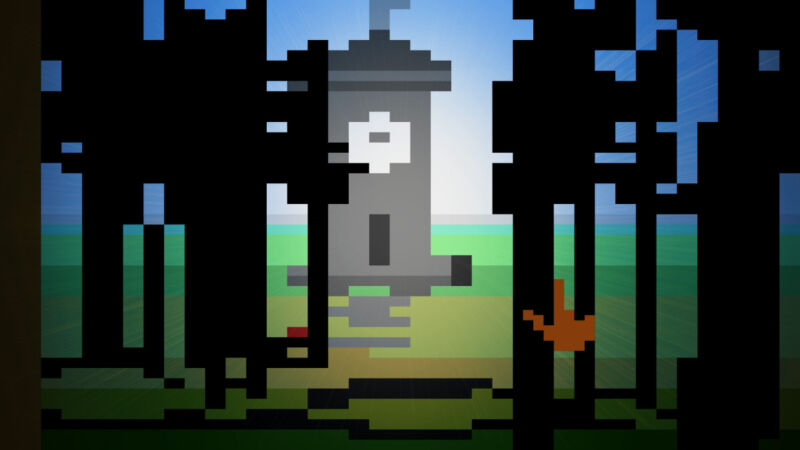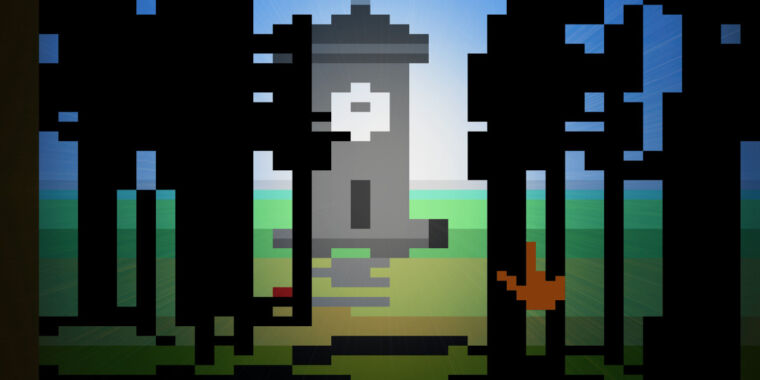
Vince Weaver
Nearly 30 years after its release on the Mac in 1993, Cyan’s Myst is still as unstoppable as ever. As one of the most successful (yet sometimes divisive) computer games of all time, it sold 6 million boxed copies in the 1990s and later ended up on over a dozen platforms, with remakes counting for even more appearances, including a VR version. Now, thanks to an unofficial hobby project by Vince Weaver, Myst can add one more platform to the list: Atari 2600.
Vince Weaver is an associate professor at the University of Maine in Computer Engineering. Since last year, he has been working on a partial “demake” of the famous point-and-click adventure game that runs on Atari’s 8-bit game system, and he just returned to the project to make updates last week.
For those not in the gaming community, the term “demake” might need some unpacking. A demake is essentially the opposite of a remake: instead of upgrading a game to fit modern standards, a demake takes a modern or classic game and adapts it for older, less powerful hardware.
“Making demakes is a hobby of mine,” Weaver told Ars in an email interview. “In the past, I’ve mostly done them for the Apple II platform, but about a year ago, I started making some for the Atari 2600. The demake sort of started out as me making a sort of small proof-of-concept version of things as a joke, but then when I get positive feedback, I get a bit carried away.”
The 2600—a game console released in 1977 with only 128 bytes of RAM and a maximum resolution of 160×192 pixels—may seem an unlikely home for the graphically-rich multimedia extravaganza that was Myst in 1993. It’s a game once considered so large that it became a killer app for CD-ROM. But the disparity between platforms is exactly the point—because the translation process poses an interesting challenge.
-
A comparison of the gear island in the original Myst (left) with the Atari 2600 version (right).
Cyan / Vince Weaver -
A comparison of the clock tower in the original Myst (left) with the Atari 2600 version (right).
Cyan / Vince Weaver -
A comparison of a linking book in the original Myst (left) with the Atari 2600 version (right).
Cyan / Vince Weaver -
A comparison of the rocket ship in the original Myst (left) with the Atari 2600 version (right).
Cyan / Vince Weaver -
A comparison of Atrus in the original Myst (left) with the Atari 2600 version (right).
Cyan / Vince Weaver -
A comparison of the big gear in the original Myst (left) with the Atari 2600 version (right).
Cyan / Vince Weaver -
A comparison of a bookshelf in the original Myst (left) with the Atari 2600 version (right).
Cyan / Vince Weaver
“The biggest challenge on doing a demake for something like Myst is the graphics,” says Weaver. “Back in the ’90s, Myst was famous for having stunningly nice rendered graphics. Translating that to old 8-bit machines is hard. It’s even more difficult on the 2600 as you are constantly racing the beam and have some extreme limitations. For example, generally, you can only have two colors per line, and anything more than that takes a lot of tricky coding.”
Due to console limitations, Weaver doesn’t plan to port the entire game over to the primitive 8-bit console, but he wants to get enough puzzles working to make it “real” game, as he writes on his website: “The full game requires at least 800 scenes, which would be roughly 200k, which would be both a pretty hefty cartridge as well as a lot of graphics to draw.”

